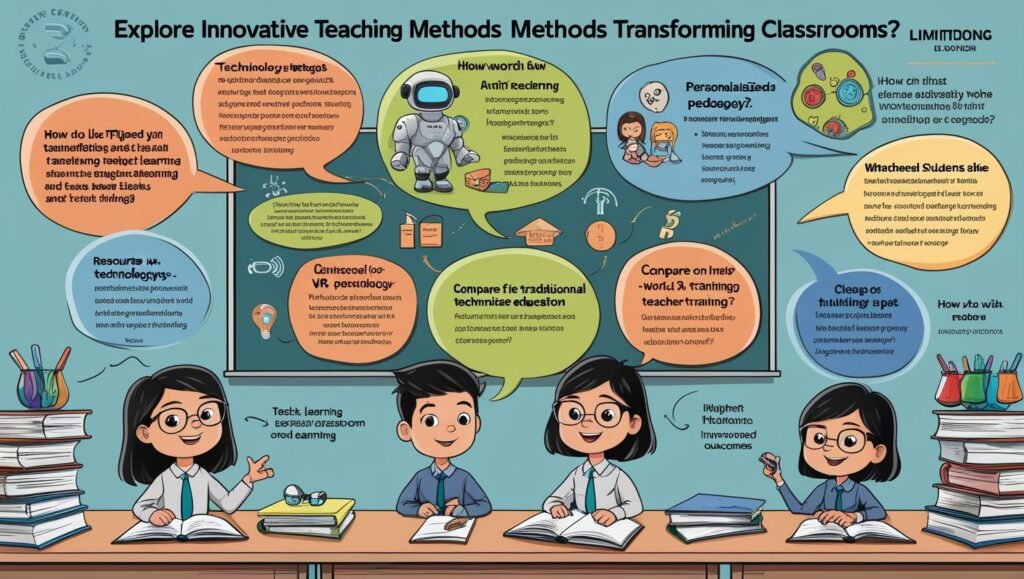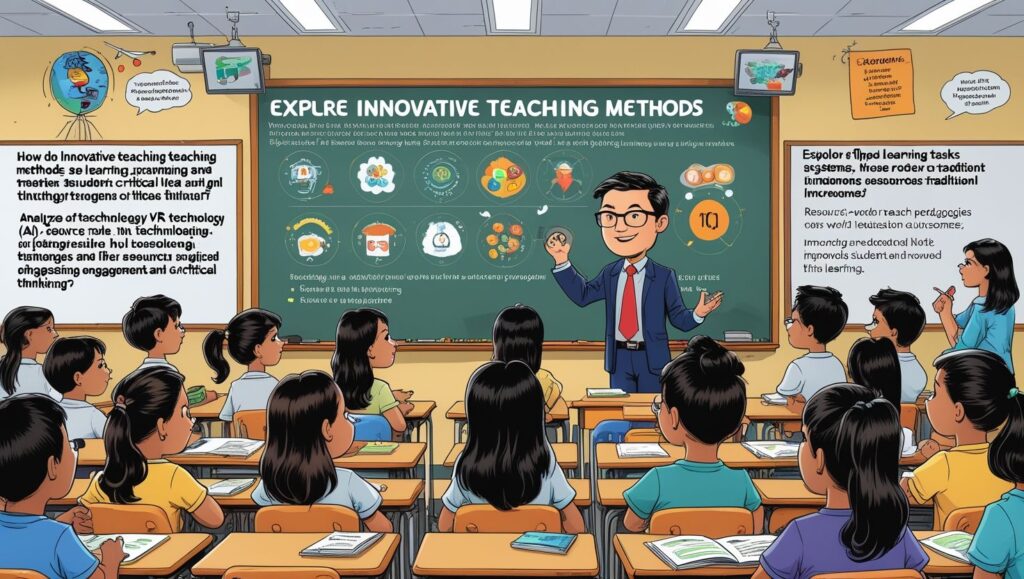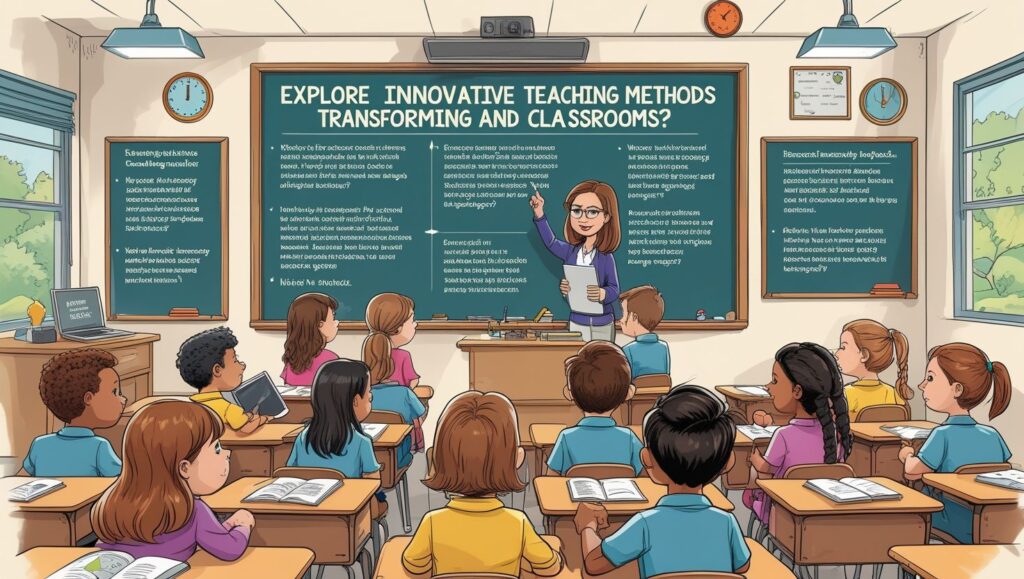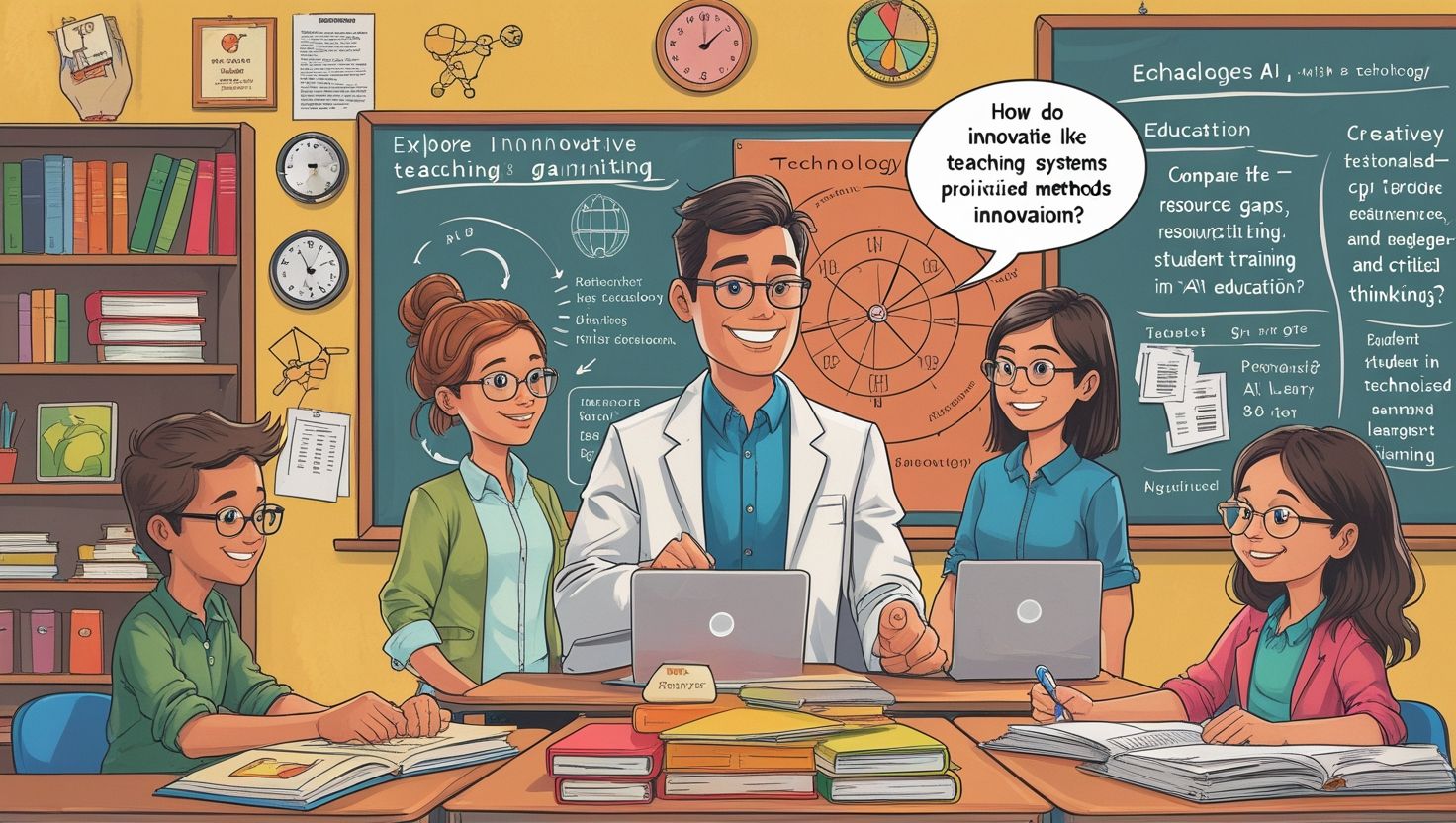1. Introduction
Innovative Teaching in Classroom, Innovative teaching refers to the use of new, creative, and engaging strategies to enhance learning in the classroom. Unlike traditional methods that rely heavily on lectures and rote memorization, innovative teaching emphasizes interaction, critical thinking, collaboration, and the application of knowledge to real-world problems. It’s about moving beyond the textbook to create a learning environment where students are actively involved in their own education.
In the 21st century, the need for innovation in education has increased due to technological advancements, globalization, and the shifting expectations of learners. Students today are more tech-savvy and require dynamic learning experiences that keep them engaged. Innovative teaching also prepares students for future challenges by developing problem-solving skills, adaptability, and creativity. Teachers play a crucial role in implementing these practices by designing lessons that stimulate curiosity and foster independent thinking. Ultimately, innovative teaching makes learning more meaningful, enjoyable, and effective, helping students to not only absorb information but to apply it in diverse contexts.
2. Importance of Innovation in Education
The importance of innovation in education lies in its ability to address the evolving needs of students and society. Traditional teaching methods often fail to engage students or prepare them adequately for real-world challenges. Innovative teaching, on the other hand, provides diverse opportunities for exploration, creativity, and deeper understanding. It helps students develop essential 21st-century skills such as collaboration, communication, and digital literacy. Moreover, innovation encourages lifelong learning by promoting curiosity and adaptability.
For teachers, it allows more flexibility in pedagogy, enabling them to tailor lessons to individual learning styles and needs. It can also boost classroom morale and enthusiasm, making education a shared adventure rather than a monotonous task. With the increasing diversity of learners in classrooms, including those with different needs or different cultural backgrounds, innovation ensures inclusivity and equity. By continually evolving teaching strategies, educators can make sure that learning remains relevant and impactful. Therefore, innovation is not just an option in education—it is a necessity for progress and excellence.
3. Role of Technology in Innovative Teaching
Technology plays a pivotal role in transforming traditional teaching into an innovative learning experience. Digital tools such as interactive whiteboards, tablets, learning apps, and online platforms make lessons more engaging and accessible. Virtual and augmented reality can bring abstract concepts to life, enabling students to explore environments like space or ancient civilizations without leaving the classroom. Learning management systems (LMS) like Google Classroom or Moodle allow for easy sharing of resources, assignments, and feedback.
Technology also supports personalized learning, where students can learn at their own pace using adaptive software. Moreover, it facilitates collaboration through forums, group chats, and shared documents, encouraging teamwork even beyond the classroom. Teachers benefit as well by using technology to assess student performance, track progress, and gather real-time data for informed instruction. During events like the COVID-19 pandemic, technology ensured continuity of learning through virtual classrooms. Thus, the integration of technology in education is a cornerstone of innovative teaching, expanding both the reach and effectiveness of instruction.

4. Project-Based Learning (PBL)
Project-Based Learning (PBL) is a student-centered pedagogy that involves learning through the completion of real-world projects. Instead of traditional lectures and tests, students explore complex questions or challenges over extended periods, culminating in presentations or tangible products. PBL fosters critical thinking, collaboration, communication, and problem-solving skills. Students learn to research, evaluate sources, make decisions, and take ownership of their learning.
Teachers act as facilitators, guiding students through the process and offering support when needed. For example, a science project on water pollution might involve data collection, community interviews, solution proposals, and presentations. This experiential learning model not only makes content more memorable but also cultivates responsibility and self-direction. Assessment in PBL is usually performance-based and includes peer reviews, reflections, and teacher evaluations. By connecting classroom learning with real-life applications, PBL helps students understand the relevance of their education and prepares them for future careers. Overall, it is a powerful example of innovative teaching that inspires deeper learning and engagement.
5. Flipped Classroom Approach
The flipped classroom is an innovative model where traditional learning structures are reversed. In a flipped classroom, students first explore new content at home through videos, readings, or podcasts, and then use classroom time for discussion, activities, and problem-solving. This shift allows more time for interactive, hands-on learning and personalized teacher support. Instead of passively listening to lectures, students come to class prepared to engage with the material. Teachers can address individual doubts, foster collaboration through group work, and encourage active participation. This method promotes better retention and understanding since students process the information before applying it in class.
The flipped classroom also encourages accountability, as students are responsible for their pre-class preparation. Additionally, it caters to different learning paces—students can pause, rewind, or revisit the material as needed. When implemented effectively, the flipped classroom can enhance motivation, deepen comprehension, and improve academic outcomes. It exemplifies how a simple change in teaching structure can lead to more effective and innovative education.
6. Gamification in Learning
Gamification refers to the use of game elements in non-game contexts like education to boost student engagement and motivation. Incorporating badges, points, leaderboards, and challenges in classroom activities turns learning into a fun and interactive experience. Gamification enhances participation and encourages a growth mindset by rewarding effort and progress rather than just results. For example, a math teacher might use a point system for completed exercises or a history quiz structured like a game show.
These strategies appeal to students’ natural desire for achievement and competition. Gamified learning environments also promote teamwork and healthy peer interaction. Moreover, immediate feedback through games helps students learn from their mistakes in a low-stress setting. Technology makes gamification easier to implement with platforms like Kahoot!, Quizizz, and Classcraft. Beyond engagement, gamification supports learning outcomes by making abstract concepts more concrete and memorable. Thus, when used wisely, gamification transforms the classroom into a dynamic learning arena, proving that education and enjoyment can go hand in hand.

7. Inquiry-Based Learning
Inquiry-Based Learning (IBL) is an educational approach that emphasizes the learner’s role in the discovery process. Students are encouraged to ask questions, conduct investigations, and build knowledge through exploration and experimentation. Instead of being given facts, they are guided to seek answers themselves, fostering independence and curiosity. Teachers act as facilitators, helping students frame questions, develop hypotheses, and analyze findings.
This method promotes critical thinking, creativity, and a deeper understanding of the subject matter. For instance, a science class might investigate the causes of climate change through data analysis and research, rather than simply reading about it. IBL can be applied across disciplines and supports diverse learning styles. It also helps students develop research skills, perseverance, and a sense of intellectual ownership. While it may require more planning and flexibility, the outcomes of IBL are often richer and longer-lasting. As a form of innovative teaching, it transforms the classroom into a space for exploration and intellectual adventure.
8. Collaborative Learning
Collaborative learning involves students working together in groups to achieve shared academic goals. This method encourages cooperation, dialogue, and mutual support, making it an effective tool for developing interpersonal and communication skills. In collaborative settings, students learn from each other by explaining concepts, asking questions, and challenging viewpoints. Tasks such as joint problem-solving, group projects, and peer reviews promote critical thinking and deepen understanding. Teachers play a crucial role by designing group activities that require meaningful interaction and by ensuring all students participate actively.
Collaborative learning also mirrors real-world scenarios, where teamwork and group decision-making are essential. It reduces isolation, builds community, and creates a positive learning environment. Moreover, it accommodates different perspectives, enhancing creativity and innovation. Technology can facilitate collaboration through shared online documents, discussion forums, and digital whiteboards. When well-structured, collaborative learning leads to higher engagement, stronger knowledge retention, and better academic outcomes. It exemplifies how innovation in teaching can extend beyond content delivery to include social and emotional learning.
9. Differentiated Instruction
Differentiated instruction is an innovative teaching strategy that tailors learning experiences to meet the diverse needs of students. It acknowledges that students have different backgrounds, abilities, interests, and learning styles. Teachers use various methods to deliver content—such as visual aids, hands-on activities, and interactive discussions—to cater to these differences. Assessment methods are also diversified, allowing students to demonstrate their understanding in multiple ways, like oral presentations, creative projects, or written reports. Differentiation can occur in content, process, product, or learning environment.
For instance, in a reading lesson, advanced readers might analyze themes while others focus on vocabulary building. This approach increases engagement, promotes inclusion, and enhances student confidence. It also helps close achievement gaps by providing equitable opportunities for success. Implementing differentiated instruction requires careful planning, continuous assessment, and a flexible mindset. However, its impact on student learning and classroom dynamics is profound. As an embodiment of innovative teaching, differentiation ensures that education is responsive, personalized, and effective.
10. Use of Real-Life Connections
Connecting classroom lessons to real-life situations makes learning more relevant and meaningful for students. When students see how their studies apply to everyday life or future careers, they are more motivated to engage and retain information. Teachers can use examples from current events, community issues, or personal experiences to illustrate concepts. For example, a math lesson on percentages might involve calculating discounts during shopping, or a geography class might explore the local impact of climate change.
Field trips, guest speakers, and service-learning projects further enhance these connections. Real-life integration also helps develop problem-solving and critical-thinking skills, as students are challenged to apply knowledge in practical contexts. Additionally, it supports interdisciplinary learning by linking subjects like science, economics, and social studies. Students gain a deeper appreciation for their education and understand its value beyond exams. Innovative teaching thrives on this approach because it bridges the gap between theoretical knowledge and real-world application, preparing students for lifelong learning and civic responsibility.
11. Emotional Intelligence and SEL in Teaching
Emotional Intelligence (EI) and Social-Emotional Learning (SEL) are increasingly recognized as essential components of innovative teaching. SEL involves helping students understand and manage emotions, set goals, show empathy, and maintain positive relationships. These skills are crucial for academic success and overall well-being. In the classroom, teachers can promote SEL through mindfulness exercises, conflict resolution activities, and discussions about feelings and ethics. Creating a safe and supportive environment encourages open communication and trust. Teachers who model emotional intelligence—by demonstrating empathy, self-awareness, and resilience—help students develop these traits.
Integrating SEL into daily lessons fosters a culture of respect and collaboration, reducing behavioral issues and enhancing student focus. It also supports mental health, which is vital in today’s fast-paced, high-pressure educational landscape. SEL and EI are not extras but foundational elements that support cognitive learning. By addressing the emotional and social aspects of education, innovative teaching nurtures the whole child, preparing them for both academic achievement and life beyond the classroom.

12. Assessment for Learning
Assessment for learning (AfL) is an approach that uses ongoing assessment to inform and improve teaching and learning. Unlike traditional assessments that occur at the end of a unit, AfL is integrated throughout the learning process. It includes techniques like questioning, peer assessment, self-evaluation, and formative quizzes. The goal is to provide feedback that helps students understand their progress and identify areas for improvement. Teachers use this feedback to adjust instruction and support individual needs.
AfL promotes a growth mindset by emphasizing progress rather than grades. It encourages students to take ownership of their learning, set goals, and reflect on their performance. Innovative tools such as digital rubrics, learning analytics, and e-portfolios enhance the AfL process. When students are involved in assessment, they become more engaged and motivated. AfL transforms the classroom into a dynamic, responsive learning environment. As a cornerstone of innovative teaching, it ensures that assessment is not merely a judgment tool, but a powerful driver of learning.
13. Challenges and Solutions in Implementing Innovation
Despite its many benefits, implementing innovative teaching comes with challenges. Resistance to change, lack of resources, limited professional development, and rigid curricula can hinder innovation. Teachers may feel overwhelmed by new technology or unsure how to shift from traditional methods. Students may also need time to adapt to more active and collaborative learning roles. To overcome these obstacles, school leadership must support innovation by providing training, time for planning, and access to tools and resources.
Encouraging a culture of experimentation and risk-taking allows teachers to try new methods without fear of failure. Collaboration among educators can lead to shared best practices and peer support. It’s also important to involve students and parents in the process to build a community of learners. Policymakers should support flexible standards that allow creativity in the classroom. By addressing these barriers thoughtfully, schools can foster an environment where innovation thrives. Ultimately, the benefits of innovative teaching far outweigh the challenges, making persistence worthwhile.
14. Conclusion and Future Outlook
Innovative teaching is not a one-size-fits-all solution, but a dynamic and evolving approach to education. It redefines the role of both teacher and student, shifting the classroom from a place of passive learning to an active hub of creativity, inquiry, and collaboration. As the world continues to change rapidly, education must keep pace by adopting methods that prepare students for complex, unpredictable futures. The integration of technology, project-based learning, emotional intelligence, and personalized instruction represents just the beginning.
In the future, classrooms will likely become even more connected, interactive, and student-centered, blending virtual and physical spaces. Teachers will need continuous professional development to stay updated and inspired. Moreover, educational systems must prioritize innovation as a core value, not just an optional enhancement. By embracing innovative teaching today, educators lay the groundwork for a more engaged, skilled, and thoughtful generation. Innovation in education is not merely about tools and techniques—it’s about transforming the very purpose and power of learning.

Saya suka cara penulisannya, jelas dan mudah dipahami.
Definitely, what a fantastic blog and revealing posts, I definitely will bookmark your website.Have an awsome day!
Adorei este site. Pra saber mais detalhes acesse o site e descubra mais. Todas as informações contidas são conteúdos relevantes e exclusivos. Tudo que você precisa saber está ta lá.
amei este site. Para saber mais detalhes acesse nosso site e descubra mais. Todas as informações contidas são informações relevantes e exclusivas. Tudo que você precisa saber está está lá.
Hi there very cool site!! Man .. Excellent .. Amazing .. I’ll bookmark your blog and take the feeds also?KI’m happy to seek out a lot of helpful info right here in the post, we want work out extra strategies on this regard, thanks for sharing. . . . . .
I was just seeking this information for a while. After 6 hours of continuous Googleing, finally I got it in your website. I wonder what is the lack of Google strategy that do not rank this kind of informative web sites in top of the list. Generally the top sites are full of garbage.
Hi , I do believe this is an excellent blog. I stumbled upon it on Yahoo , i will come back once again. Money and freedom is the best way to change, may you be rich and help other people.
I precisely needed to thank you very much all over again. I do not know the things that I might have created in the absence of the ideas revealed by you directly on my topic. It seemed to be the terrifying condition in my opinion, but being able to see your specialised mode you dealt with the issue made me to weep for delight. I am happy for your service and then pray you are aware of a great job that you’re undertaking educating some other people all through a site. Most probably you haven’t encountered any of us.
It’s the best time to make some plans for the longer term and it is time to be happy. I’ve learn this publish and if I could I desire to suggest you few attention-grabbing issues or tips. Maybe you could write subsequent articles regarding this article. I want to read even more issues approximately it!
Официальный Telegram канал 1win Casinо. Казинo и ставки от 1вин. Фриспины, актуальное зеркало официального сайта 1 win. Регистрируйся в ван вин, соверши вход в один вин, получай бонус используя промокод и начните играть на реальные деньги.
https://t.me/s/Official_1win_kanal/3911
Very good site you have here but I was wondering if you knew of any user discussion forums that cover the same topics talked about here? I’d really love to be a part of community where I can get advice from other experienced individuals that share the same interest. If you have any suggestions, please let me know. Many thanks!
I’m not that much of a online reader to be honest but your sites really nice, keep it up! I’ll go ahead and bookmark your site to come back later. All the best
you’ve got an amazing weblog here! would you prefer to make some invite posts on my weblog?
This is a very good tips especially to those new to blogosphere, brief and accurate information… Thanks for sharing this one. A must read article.